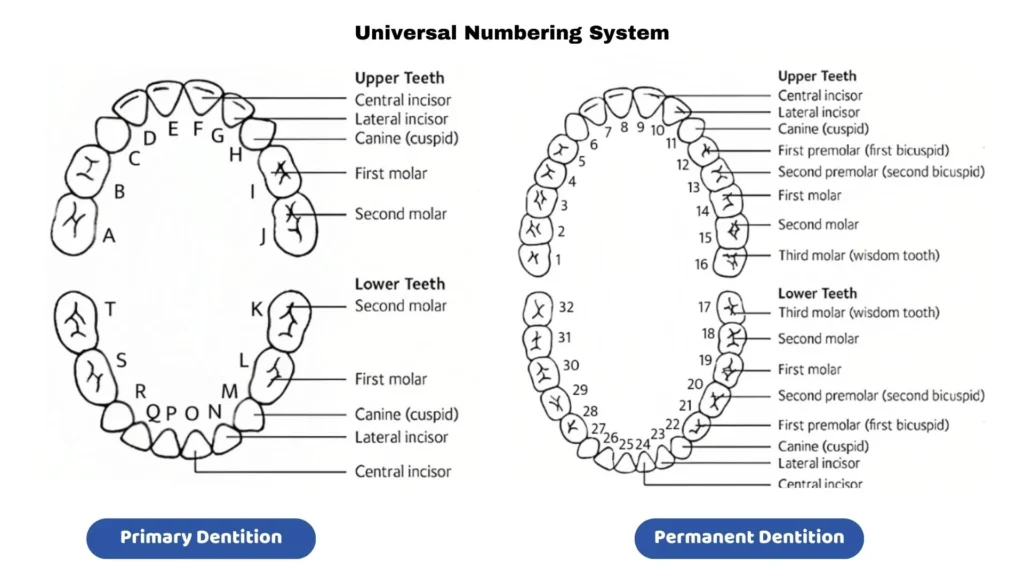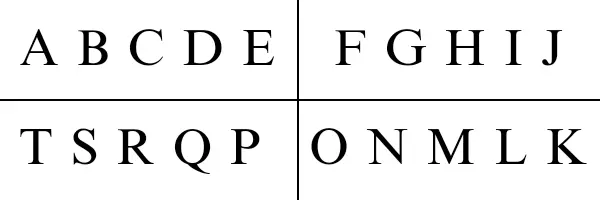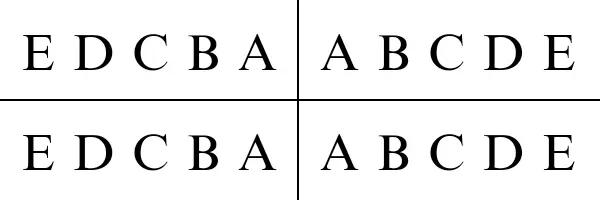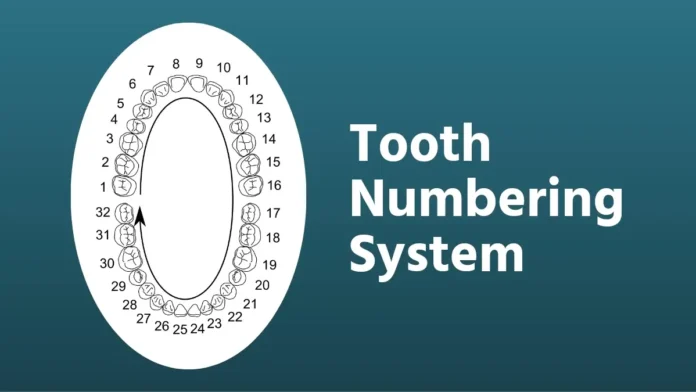Have you seen a dentist taking records of teeth with numbers in your dental examination and wondered how teeth are numbered? There is no need to think much as it is a standardized way of making teeth records with teeth numbers instead of names. It is also called the Tooth Notation System or Tooth Numbering System.
Why Do Dentists Use Teeth Numbering Systems?
It helps for easy and quick records of teeth for diagnosis and treatment planning, professional communication with other dentists, dental insurance claims requiring specific tooth location information, dental education, and dental research for accurate data records. Many types of tooth numbering systems are available, but the Universal Notation System for teeth records is widely used globally, also known as Universal Numbering System.
So next time you see those numbers on your dental record, know that they’re doing a lot more than just labeling teeth—they’re helping keep your dental care organized, accurate, and accessible.
Different types of Tooth Numbering Systems
- Universal Notation System or Universal Tooth Numbering System
- Zsigmondy/Palmer Notation System
- FDI (Federation Dentaire Internationale) is also known as the two-digit system
1. Universal Notation System (Universal Tooth Numbering System)
In 1968, the ADA (American Dental Association) officially recommended the “Universal Tooth Numbering System”. It is a widely used tooth numbering system, especially in the United States. It can be used in both primary and permanent dentition.

For Primary Dentition
The universal numbering system uses uppercase letters for the primary dentition. For maxillary primary teeth, begin with the right second molar with the letter A to the letter J, and for mandibular teeth, start with the left second molar with the letter K to the letter T. You can see the illustration given below.

For Permanent Dentition
In the universal numbering system for permanent teeth, maxillary teeth are numbered from 1 to 16, from the right maxillary third molar tooth. In mandibular teeth, it starts from 17 to 32, from the left mandibular third molar tooth. You can see the image given below for understanding.

Tooth Numbers and Their Corresponding Types
To make it easy to understand, in the Universal Numbering System, I have specified tooth numbers to each type of tooth:
- Wisdom Teeth (Third Molars): Teeth on each corner of your mouth, teeth numbered 1, 16, 17, and 32
- Molars: The molars (excluding wisdom teeth) cover numbers 2, 3, 14, 15 (upper jaw) and 18, 19, 30, 31 (lower jaw)
- Incisors: Your front and most visible teeth, incisors are numbered 7–10 in the upper jaw and 23–26 in the lower jaw
- Canines (Cuspids): The pointed “eye teeth” or canines take numbers 6 and 11 (upper) and 22 and 27 (lower)
- Bicuspids (Premolars): Located between canines and molars, premolars are assigned numbers 4, 5, 12, 13 (upper jaw), and 20, 21, 28, 29 (lower jaw)
2. Zsigmondy/Palmer Notation System
In 1947, the ADA (American Dental Association) officially recommended the “Zsigmondy/Palmer Notation System” as the numbering method of choice later it was replaced with the “Universal Numbering System”. It can be used in both primary and permanent dentition.
For Primary Dentition

For primary dentition, starts from the midline with uppercase letters from A to E on each side, where A refers to the central incisors and E refers to the second molar.
For Permanent Dentition

For permanent dentition, it starts from the midline with numbers from 1 to 8 on each side, where 1 refers to the central incisors and 8 refers to the third molar.
3. FDI or Two-digit Numbering System
The Federation Dentaire Internationale proposes it for primary and permanent dentition. It is adopted by the World Health Organization and other organizations like the International Association for Dental Research.
For Primary Dentition

Here, in the 51 the first digit 5 represents the right maxillary side or right upper quadrant, and in the 61 the first 6 represents the left maxillary side or left upper quadrant. The second digit represents the tooth number for each side. It is the same for the mandibular arch as well.
For Permanent Dentition

Here, in the 11 the first digit 1 represents the right maxillary side or right upper quadrant, and in the 21 the first 2 represents the left maxillary side or left upper quadrant. The second digit represents the tooth number for each side. It is the same for the mandibular arch as well.
Frequently asked questions
Which Tooth Numbering System is most commonly used in the United States?
The Universal Numbering System is the most commonly used tooth numbering system in the United States.
How are Teeth Numbered in Australia?
The FDI (Federation Dentaire Internationale) or the Two-digit numbering system proposed by WHO is used to number teeth in Australia.
Which Tooth Numbering System is Used in Canada?
The FDI (Federation Dentaire Internationale) or a Two-digit system is used in Canada.
Which Tooth Numbering System is Widely Used?
The Universal Numbering System is a widely used tooth numbering system globally.
Which Primary tooth is designated J using the Universal Numbering System?
Left Second Molar (last tooth in the upper primary tooth arch) is designated using the Universal Numbering System.
I hope this informative post helped you learn how teeth are numbered with various tooth numbering systems with teeth numbers and names. You can contact us if you have any questions or feedback. Share this article with your friends and family to make them aware.

